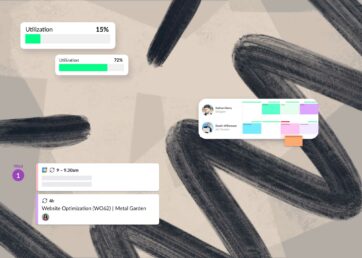The most difficult project I’ve worked on took place a few years ago—it was a complex development project with a somewhat rude client and a team that was enthusiastic but in over our heads. We struggled with our project velocity, allowing scope creep to influence our resource allocation and blowing our personal schedules by working late nights, early mornings, and through holidays.
Not surprisingly, the whole team was completely burned out after this project. We lost interest in our work and carried exhaustion with us on every project after that for weeks.
Since then, I’ve learned more than a few things about what we could have done better—and how we could have refocused our team. While my team was faced with difficult project specs and an ever-changing client opinion, their work also wasn’t made any easier by the project schedule, communication, and expectation setting—leading right to project burnout once we launched. Getting to the point of burnout is never ideal on any team, especially with a project that’s already challenging. It’s possible to avoid this by anticipating a few key things on every project—here’s what I’ve found works for me.
In this article 📖
Communicate regularly—and the right way.
It’s something we all know, but it’s worth saying again: project management really starts with communication. In the difficult project I spoke of earlier, we faced many issues around communication. We would communicate frequently, but not efficiently, spending hours in meetings together, co-working through issues that would have been more easily solved by pair-programming sessions or in small department meetings. Choosing who needs to be involved in project issues and when would have saved us lots of time—and also lots of mental capacity.
“Project management really starts with communication”
Communicating regularly is extremely important on a high-velocity project, but the quality of communication also matters. A quick check-in with my team in the mornings and before we all finished for the day was helpful to share and tackle roadblocks or progress in small bursts as we moved along the project. The scale of communication quality to time spent in those meetings was extremely positive. Longer discussions about particular project needs are usually better left to one-on-ones or small meetings, so that the team doesn’t have to sit through large chunks of time not targeted to their work.
Most importantly, there is a lot of project management communication that can take place right within our project tools and be input/reviewed asynchronously—which is exactly what those tools are for. Activities such as recording project scope changes, project scheduling and resource management are better left to these tools, where they can be reviewed by any team member and filtered as needed for concise information.
Be extremely mindful of project scheduling.
One thing I wish I had done differently on that project years ago was scheduling my team more carefully—or doing any project scheduling at all. At the time we weren’t using any resource scheduling software. This falsely made it seem as though project capacity planning was easy: I gave my team tasks for the day/week, and they would do them. However, the reality was so much more difficult. My team did not have a clear understanding of where other priorities fit in, I didn’t have a clear expectation as to when things might get done if other work came up, and it ended with all of us working far more hours than we should have (or was good for us).
“Project capacity planning sets the stage for motivated, happy teams—and happy, informed project managers.”
Project capacity planning sets the stage for motivated, happy teams—and happy, informed project managers. This is something I wish I had realized sooner in the past—it would have prevented so much stress on the team during my projects. Being able to book, update, and review time spent on projects by resource planning (with tools like Resource Guru!) makes a huge difference in project clarity and task management for the team and the project manager on a project. The reality of working on projects is that things constantly change, and rarely does a team work on one single project at length—so it’s important to have insight into this in a realistic way in order to avoid burnout. The visibility into how a team is booked on any project(s) gives the whole team transparency into potential issues, gaps in project coverage, and especially overbooking insight. That leads to much less risk of burnout on a project team overall.

Tools like Resource Guru help you schedule resources realistically, and avoid team burnout.
Be clear about expectations and set them accordingly.
If there’s one thing I’ve learned time and time again, it’s that it’s better to over-communicate any and every expectation than to leave something unsaid. Project issues can be avoided by simply stating an expectation rather than making an assumption, whether that’s with a client, or my team. The difficult project I worked on was rife with expectation issues—assumptions that we would work through late nights as a team to get things done, unclear objectives in team meetings, and of course, all of the expectation issues that come hand-in-hand with scope creep that isn’t contained. This all culminated in the team being in various stages of burnout through the project because we were frequently not on the same page about work and over- or under-compensating our efforts to adjust for this.

“Resource Guru has significantly improved our visibility, boosting project ownership and forecasting ability.”
Expectation-setting can be made in broad strokes, such as setting an expectation (and repeating/upholding it) from the start of a project as to how scope creep will be addressed, or setting an expectation with the team regarding communication for the project on a daily/weekly basis. These larger, project-wide expectations are often difficult to uphold if the expectation is not clearly stated and defined. In order to work, they must be repeated throughout a project consistently, so that the expectation is not conflicting with other, previously set expectations. But this is easy to do on a much smaller scale as well—for example, things like setting expectations at the beginning of a meeting, regular expectation setting with a client on weekly check-in communications, or reinforcing the expectation that everyone takes the weekend or evening off from work. These large and small expectations add up to create more clarity and transparency into a project, which ultimately reduces the type of project friction that leads to burnout.
You’ve got this!
The most important thing to avoid project burnout with your team is to create transparency and visibility into your projects, whether that starts with resource scheduling, quality communication, or clear expectations. While it might seem that project burnout is inevitable for your team on a project, these tips will help you avoid total team burnout if implemented on a project—even if you’ve already gotten started. I hope that these give you a starting place to provide more clear leadership with your team when the going gets tough. Let us know if you have any additional practices that help your team below!
Learn more about project scheduling in our free guide to resource management






